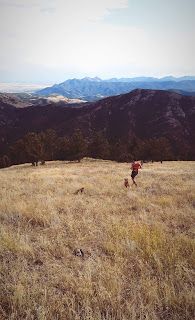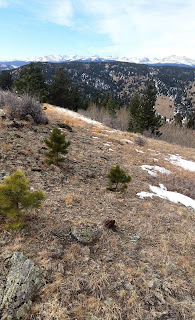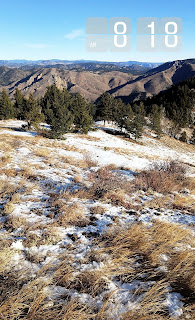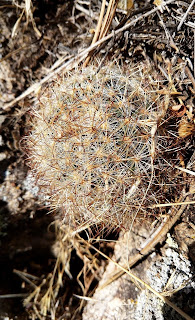Optical Reality
The equator-facing slope where I pitch my tent receives
something like 85% more solar radiation annually than its pole-facing friend,
just a football field or two across the canyon. Why? Mostly because of a
fundamental optical property of the universe that you likely learned about in
high school physics and may occupy a dusty corner of your intuition: the
intensity of light incident upon a surface is maximized at right angles to that
surface.
Compared to a flat plane at the latitude and elevation of Nugget
Hill (~40.1 degrees north, ~7000 feet), sun on the south-facing slope is
augmented by about 15% due to the slope’s equatorward inclination. On the far
side of the canyon, sun on the north-facing slope is attenuated about 20% by
the slope’s poleward inclination. Dense lodgepole pine forest intercepts
another 15%. Finally, horizon shading – later sunrises and earlier sunsets
created by ridgelines at the crest of the slope – reduces radiation by an additional
5%.
Physical differences create two distinct worlds. The
north-facing slope is dark, wet, and mysterious, a moody forest of moss and
pine. The south-facing slope is bright, dry, and crisp, a desert landscape of
yucca and juniper. On the Colorado Front Range, north-facing slopes are
often steeper than their south-facing relatives, perhaps due to dense
forest that dams soil and prevents erosion. Water flows differently through the
slopes. Snow melts rapidly on the south-facing slope and infiltrates vertically
downward through thin, mineral soil, weathering underlying bedrock. On the
north-facing slope, snow melts more slowly and seeps laterally downslope through
thick, organic soil.
Geologic Genesis
What is unique about the Colorado Front Range? Why don’t all
locations on Earth feature steep east-west trending canyons? The story begins
around 70 million years ago, when the shallow subduction of the Kula and
Farallon plates beneath the North American plate thrust old, hard granitic rock
up against young, soft marine sediments from the Cretaceous seaway in a series
of mountain building events known as the “Laramide Orogeny”. The orientation of
the shallow subduction forced the Front Range mountains upward in a north-south
oriented massif.
Pleistocene glaciation near the high peaks gouged wide
U-shaped valleys, and melted snow and ice flows eastward below glacier
elevations, incising narrow V-shaped canyons. Pre-Columbian people of the Front
Range drove elk, moose, and bighorn sheep into these U-shaped valleys during the
mild months of August and September and trapped them near the sheer valley
walls. Ancient tools, blinds, and campsites have been found throughout the land
now known as Rocky Mountain National Park and Indian Peaks Wilderness.
Solar Garden
Fast forward a few years to August 2019, when your friendly
neighborhood solar psychonaut pitches his tent on a flat, sunny terrace. The lack
of moisture in high Colorado air allows for dramatic daily heat cycles:
afternoons are Mexico, nights are Canada. August and September are precious months
in the high country – crisp clear mornings rise to spicy shimmering afternoons – a fleeting climax that brings out deep ruby in tomatoes, bronze on skin. This
special time comes to an abrupt end one night when frozen air interrupts dreamy expansion
and shifts the mountain system into its winter cycle. Growth continues in
waves: sun fertilizes, snow irrigates. Rich emerald lodgepoles on the north-facing
slope; lime green yuccas on the south-facing slope.
Frost Frame
Among other results, some recent work (Rush et al. in
review) explains why soils tend to freeze persistently on north-facing slopes, and
only ephemerally on south-facing slopes. Snow insulates the soil from cold air,
so we would expect that soils on the south-facing slope should freeze during
frequent snow-free periods. However, solar radiation is sufficiently powerful
to prevent soil freezing during all but the most intense cold snaps. Can human
ingenuity exploit the solar advantage and prevent soil from freezing even during
these coldest nights?
Inspired by wise elders, your friendly neighborhood solar
psychonaut is determined to cultivate growth and joy. The frost frame is
constructed with a large window ($8), pipe insulation ($2), and 2 x 8’s ($2) from
a junkyard in town, as well as lumber lying around the house ($0). The inner
walls are lined with extra plastic sheets from the rabbit run and bear-proof
compost bin projects ($0) to prevent moisture from seeping into the wood. The structure
is set into the hillside and gaps are insulated with ponderosa and piñon pine woodchips
left over from fire mitigation activities ($0). Moisture stored in the
woodchips will likely rot the lumber of the frame more quickly, but sufficient insulation
is important. Compost from horse, rabbit, and goat
manure ($0) fills the bottom of the frame and organic topsoil from my advisor’s
former lab space ($0) composes the surface. Daikon seeds are planted as
a test – mostly to grow what are trendily known as “microgreens”, but maybe a
radish root or two will plunge deep into the compost base to collect moisture.
Orion's March
Nugget Hill nights are of a special kind. Orion rises in the
east just above the far wall of the canyon and hikes westward along the ridge.
When I go outside to pee, I have an immediate sense of how many hours I have
left to sleep. Full moons bring out woodland creatures: owls hoot-hoot into the
eerie silence, deer click-clack on the flagstone outside my tent. Cold air outside
invites me to burrow deep into my down sleeping bag. Steep
topography creates dramatic differences in temperature and pressure that force
harsh winds down elevation gradients. I hear the dragon above building and growing
strength for minutes before it surges down the canyon in an explosive
few seconds. Ear plugs help to keep me asleep during these noisy nights. Sub-freezing
tent life is honestly warm and cozy as long as I take a number of pragmatic
measures to protect myself. When I go to sleep, I put on fresh socks and warm
up my sleeping bag fully dressed. During snowy nights, I take advantage of
technology that allows me to avoid going outside to pee. In the morning, I
shake snow off the tent from the inside to avoid a snow shower when emerging.
When the snow melts, I shovel it away to prevent tent inundation.
Sun sets on Nugget Hill
November, the sun sinks low. In addition to the optical
effect I discussed before, low solar angles have other consequences. When the
sun is low in the sky, light beams travel a much greater distance through the
atmosphere, colliding with particles that reduce the amount of radiation received
at the surface. In the steep canyon world, low solar angles allow different
ridgelines to cast shadows. Instead of the steady creep of sunset time
experienced in flat places, a slight shift in solar angle can lead to a
dramatic contraction in the length of the solar day.
Up-Down System
Front Range humans of antiquity likely followed an up-down
migration pattern (Benedict, 1992), spending the mild late summer and early
fall months hunting game in the high country and moving to lower elevations for
the winter. In a strange reversal of this cycle made possible primarily by
cheap natural gas, I move to a colder clime for the winter. As the crow flies,
the Fraser Valley is just across the Continental Divide from the Front Range
urban corridor. Cold air masses from the mountains encircling the valley
maintain some of the lowest air temperatures in the lower 48, rivaling
International Falls, Minnesota. Each year, the region receives about 30 feet of
cold, dry powder that allows for excellent skiing at Winter Park resort, a short
8-minute drive from my home base in Fraser.



































































































































No comments:
Post a Comment